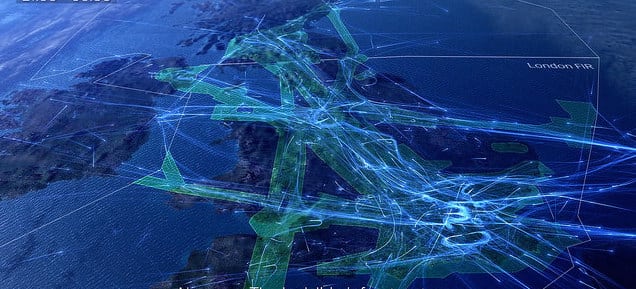[Avionics Today 06-17-2015] Your favorite shows aren’t the only things that could be travelling via TV signals; in the not-too-distant future NATS, Thales ATM UK and Roke Manor are looking to track aircraft using those same television frequencies. The team has recently completed a two-year proof of concept trial, demonstrating that standard TV signals used to deliver shows to televisions across the country could also be used to detect and direct aircraft in U.K. airspace.
 |
| Photo: NATS |
“We did one trial over London, where we tracked aircraft quite well North of London, seeing aircraft landing and taking off over Luton Airport and Stansted Airport. There was another trial over the Liverpool Bay looking specifically at wind farms and how well the system would operate in that environment because traditional radars do struggle with wind turbines. We saw that this type of technology may be less affected by wind farms, but that’s not quite conclusive,” Nick Young, a system engineer at NATS who worked extensively on the project, told Avionics Magazine.
The trial, which took place mainly over London, tracked up to 30 aircraft at any one time at altitudes of up to 10,000 feet. The trials turned up positive results in the realm of tracking, demonstrating that TV transmissions can be used to locate aircraft at the required standard separation requirements for air traffic control — 3 to 5 nautical miles. This means that TV signals could potentially be a viable alternative to traditional radar at a lower price tag.
“At the moment, our non-cooperative capabilities — that is detecting aircraft without them transmitting — is provided by traditional rotating radars everyone sees in the films and at airports. They’re quite big, they’re hefty, they’re expensive to maintain, and they take quite a lot of RF spectrum,” said Young, noting that NATS is looking to drive down costs. “This technology became worth looking into because it does overcome some of these issues [with traditional radars]. Instead of having the big rotating radars we have some small antennas, probably the size of a trash can — maybe a bit smaller — and they can be fitted on much smaller sites, potentially including commercial towers and provide the surveillance data to a certain area.”
The picture that Air Traffic Controllers (ATCs) pull from TV signals are similar to that of traditional radar. Although not identical, these can provide a complementary view of airspace alongside Automatic Dependent Surveillance-Broadcast (ADS-B) tracking tech, which is currently in the process of being implemented in European airspace. The TV tracking technology is more like traditional radar and therefore is not dependent on the aircraft’s ability to transmit a signal to track it by, meaning it can fill in the gaps of aircraft not equipped with ADS-B transmission capabilities.
 |
| With tracking through TV signals, multiple receivers allow an ATC to pinpoint the aircraft where the signals correlate. Photo: NATS |
“It is very much complementary to ADS-B,” explained Young. “In the U.K. we have gliders and general aviation aircraft that might be flying around but might not be fitted with transponders. We might be able to detect them with this technology that we otherwise wouldn’t be able to detect with ADS-B.”
This is applicable to civil aviation aircraft infringing on controlled airspace, or an aircraft where a transponder fails. “It’s rare, but it still happens,” noted Young.
And there are security implications as well when it comes to identifying aircraft that are otherwise undetectable ADS-B. “You might have remotely piloted aircraft flying around. Whether it be nefarious or not, the ability to detect these kinds of things is quite useful,” he added.
The technology is still in its infancy, however, and there are plenty of regulatory and technical hurdles the companies are looking to overcome as they enter the next phase of bringing the technology to term.
“One of the concerns we have from a legal perspective is: Can we use TV signals for an aviation purpose? Can the TV companies and TV broadcasters provide us with enough resilience to satisfy our safety assurance? Can they make sure the signals aren’t going to fall over every five minutes? I can’t remember the last time we lost a TV signal so you’d like to think that’s not the case. But we have questions that need answering,” said Young.
Outside of regulation, Young admits there are also some technical questions that still need to be answered because the technology isn’t without limitations. As the trials were conducted up to 10,000 feet, they’re not sure how far the tracking capabilities can reach or if it would be cost effective to build transmitters that can go above 20,000 feet, for instance.
Ideally, the companies are hoping to bring the technology to term in five years and begin replacing the radar systems in place now as they reach their end of life. “That’s absolutely ideal from a business perspective, assuming we can satisfy all the requirements,” said Young.
Still, while the trials have been considered viable, there’s plenty of work to be done before the technology reaches a point where it can replace current radar. And Young notes that while the Digital Video Broadcast-Terrestrial (DVB-T) signals that the partners are currently trialing have been providing the best resilience and bandwidth thus far, they are also looking into alternate forms of transmission signals, such as digital radio.
“There’s still a lot of deciding that needs to be done,” said Young. “We’re only in the preliminary stages of saying ‘This technology is capable of providing air traffic control technology,’ but there’s a lot to do before saying ‘yes it can.’”